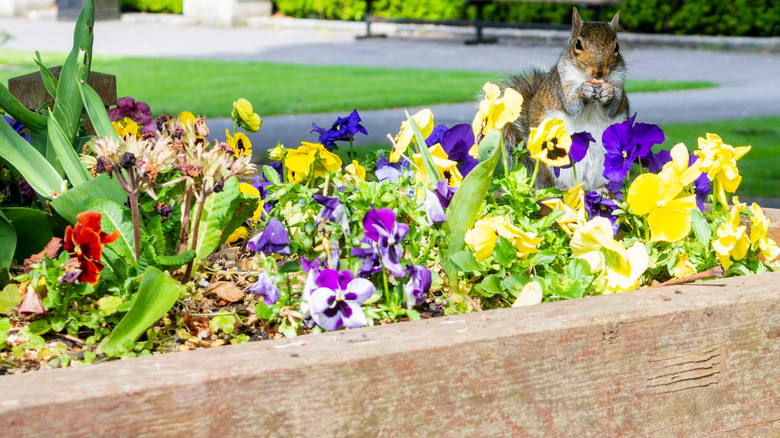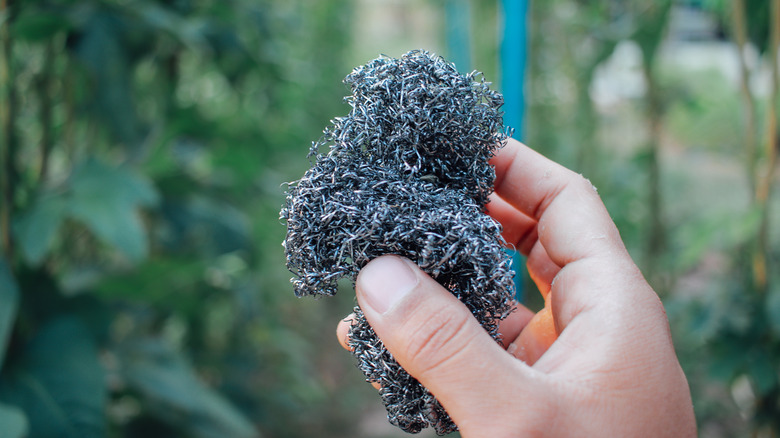Why You Should Wrap Your Flower Bulbs In Steel Wool To Ensure Beautiful Blooms
We may receive a commission on purchases made from links.
In warm climates or cold ones, everyone seems to be ecstatic when it's finally spring. And for cold climate denizens, the arrival of spring is met with more than a little joy. Usually, one of the first signs of that most wonderful of seasons is the sight of flower bulb shoots poking their bright green stems out of the earth. In some parts of the country, the sight is accompanied by a bit of snow dusting those bulbs, but even the frozen precipitation can't dampen the true gardener's enthusiasm. The sight of a hungry squirrel rooting around trying to dig up those carefully planted and nurtured bulbs, however, is another story. Hungry, fluff-tailed rodents will often make a snack of crocus, lily, and tulip bulbs.
Luckily, squirrels, rabbits, deer, and just about any other creature intent on taste-testing your tulips would need the skills of Houdini to extricate bulbs you encase in steel wool. It isn't called steel wool because it's soft and cuddly. The material we call "steel wool" really is made from steel fibers. Wrap your flower bulbs in securely in a "blanket" of steel wool, and you'll ensure beautiful blooms to grace your garden. Gardeners tell tales of trying to keep the critters away by using noxious-smelling sprays or covering freshly-planted beds with shredded leaves to disguise the smell of freshly-disrupted soil (so the squirrels don't get the idea that something yummy is hiding there). In the end, it's hard to beat the barrier method.
Sturdy steel wool keeps hungry animals from snacking on your flower bulbs
Steel wool is very strong and durable, which you might remember if you're of an age that swore by steel wool pads infused with pink or blue soap to help scour sauce pans or cookie sheets. Imagine something strong enough to withstand repeated, aggressive wresting matches with your grungiest frying pan yet soft and malleable enough to cradle little crocus bulbs. Versatile steel wool is the chameleon you're looking for, just don't forget to wear sturdy gloves when handling it. There are many important places to use steel wool, some of which you're probably missing, including various areas around your garden that need protection.
To keep your flower bulbs safe from the jaws of starving squirrels, you'll first want to purchase steel wool, like the one on Amazon that's sold in a roll. With your gloves on, cut it to the size you want using scissors (cutting through the steel should sharpen them!), tin snips, or a razor knife. Fashion a small box by manipulating the steel wool into the shape you want. Insert the bulbs with the tips pointing up, and then wrap the steel wool gently, but firmly, all around the bulbs, encasing them in the steel wool so they're ready to be dropped into a prepared hole in the ground.
Other ways to protect your flower bulbs to ensure beautiful blossoms
Wrapping your bulbs in a cozy steel wool blanket is a nearly foolproof method of safeguarding the flower bulbs from rodents with the munchies, but there are other methods that also work well, and depending on the number of bulbs you're planting or other factors, they may prove to be the better choice. A longtime tried and true method is to use chicken wire over a mass planting of bulbs. Iowa State University Extension and Outreach reminds gardeners that proper planting depth helps, as does using a layer of chicken wire. Place the bulbs, cover them with dirt, then to prevent industrious squirrels from doing a little ambitious digging, weigh the whole thing down with something heavy (a few concrete stepping stones would look nice) during the months between planting and blooming. This is a great method if you are doing a mass planting with dozens or even hundreds of bulbs. Plus, chicken wire is very inexpensive, as are concrete blocks, which also could be used to top the chicken wire.
If you aren't doing a mass planting, some gardeners prefer to create little wire cages for their bulbs. As with the steel wool coveralls, the wire cages encase the entire bulb (or groupings of bulbs) and make it difficult or impossible for the critters to access the potential food source. Cages are easy to craft yourself, but they're also readily available through various sources, like the bulb basket from Breck's.


